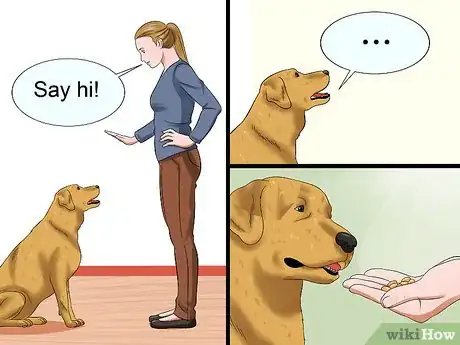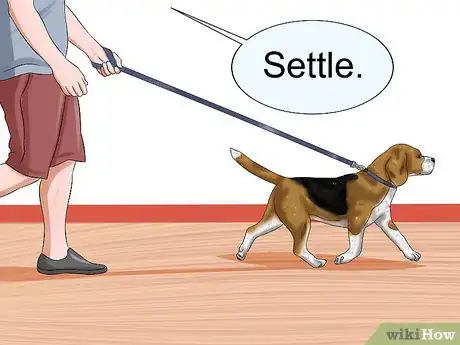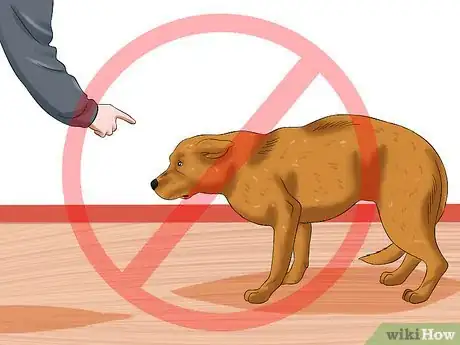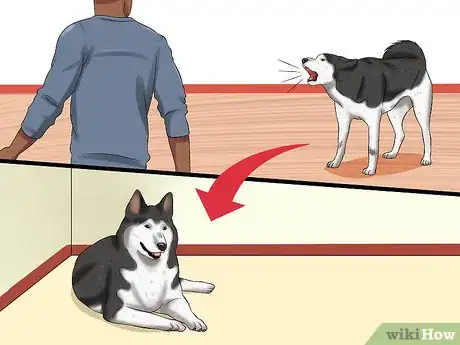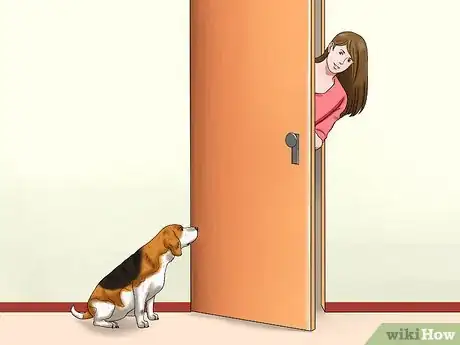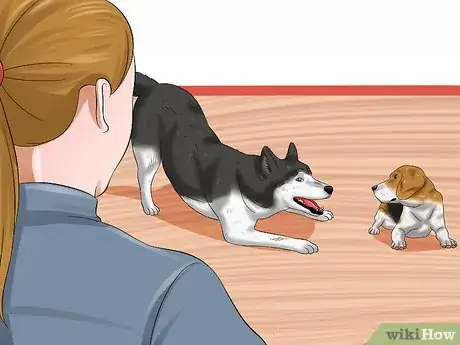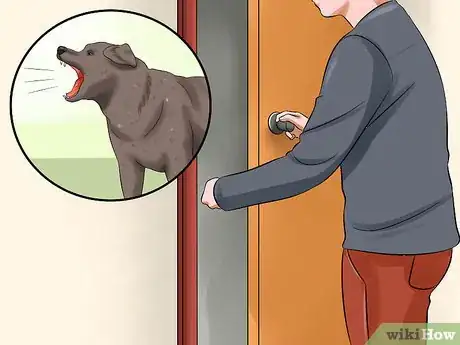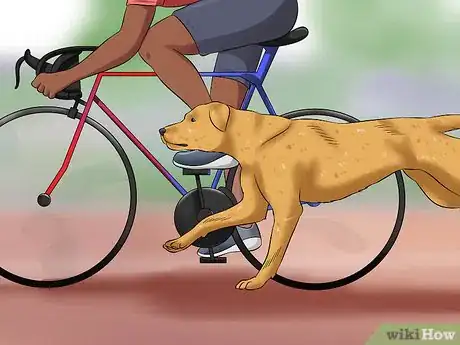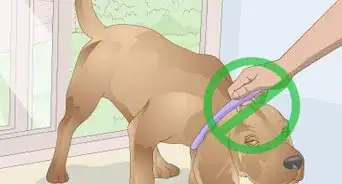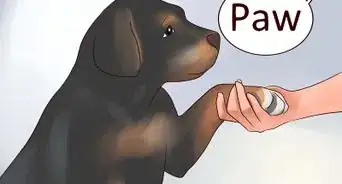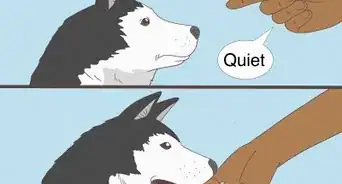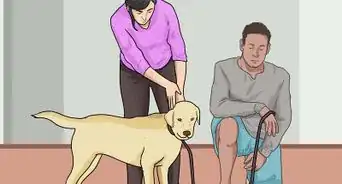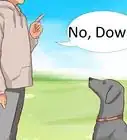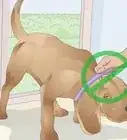This article was co-authored by Toni Woods. Toni Woods is a Professional Dog Trainer in Washington DC. With over 15 years of experience, Toni specializes in improving the relationship between dogs and their families and easing the suffering of dogs experiencing separation anxiety. Toni holds a BS in Biology from Wittenberg University and taught biology for nine years. She now dedicates her life to helping dogs with separation anxiety.
There are 16 references cited in this article, which can be found at the bottom of the page.
This article has been viewed 56,776 times.
Some dogs are naturally more energetic than others. If your dog's high energy or excitability are causing behavioral problems, you may need to work with your dog to be calmer. Training, breaking out of bad habits, and controlling/removing stimulating sources of excitement can all help make your dog become more calm and well-behaved.[1] By teaching your dog to be calmer, you'll create a more stable home life for you and your pet.
Steps
Training Your Dog
-
1Reinforce verbal commands. Verbal commands are the first line of defense for a dog that is overly-excited. Start by teaching your dog simple commands in non-distracting places that will teach them to focus on you instead of distractions.[2] For example, teach your dog to touch your hand or look you in the eye on command. Once your dog becomes more manageable, you can begin to teach more advanced commands such as "settle" or "stop".[3] Make sure you use an appropriate volume and tone of voice when giving verbal commands. You need to capture your dog's attention and give it a firm command, not a timid suggestion.
- "Watch me" is the single most important command you can teach an over excited dog. Simply say your dog's name, followed by "watch me" (or "focus") and then give a treat when your dog looks you in the eye.Over time, with consistent training, your dog will learn to look to you for a treat rather than at a distraction.[4]
- Verbal commands like "sit," "lie down," and "stay" should also all be reinforced until your dog can act on command. You may lure your dog treats, but withhold them until your dog complies with your commands.
- Say the command once, then wait for your dog to do it. Repeating the command over and over just teaches the dog to ignore what you're saying.
- Practice giving commands to your dog while you are in different positions, such as standing or crouching. If you always give commands while sitting, your dog may only listen when you're in a seated position.
- Similarly, you should practice giving verbal commands in all rooms of the house and various outdoor locations. Your dog should feel comfortable following commands anywhere and at any time before you can expect compliance in various scenarios.
- Don't keep your hands in your pockets. Your dog may associate a hand in the pocket with a reward, and you want your command to be the thing that makes your dog listen (not just a hand rustling for treats).
- Do give a lot of treats, especially when your dog is just learning a new command or returning to an old command you haven't practiced in a while.
-
2Try clicker training with your dog. Clicker training is a helpful way to teach your dog new commands and reinforce old ones. A clicker may be helpful for overly-excited dogs who won't sit or remain calm in certain situations.[5] You can buy a clicker at most pet stores or through an online retailer.
- Start with a command your dog already knows, like "sit" or "down."
- Give them command and press the clicker as soon as your dog complies, then immediately offer a treat.
- The clicker should be used to reinforce your dog's action, while the treat is given to reward the position your dog complies with (for example, sitting).
- Dog trainer Ian Stone teaches that training should always be ongoing, binary, and analog. Ongoing means that we should always aim for a running commentary on dog's behavior—otherwise, we're leaving the dog to make up its own mind.[6] Binary means we let the dog know what we do like and what we don't like, and we should do both of these things right alongside the behaviors because timing is crucial. Analog means that your response should be matched to the level of the behavior, so if the dog does something really right, you give a big reward, and vice versa.[7]
Advertisement -
3Teach your dog impulse control. Many excitable dogs benefit from impulse control training. Impulse control forces your dog to resist the urge to do whatever it wants and instead defer to your command.[8]
- Try the "say hi" command before petting your dog. Have your dog sit, say the phrase "say hi," and if your dog doesn't jump you can pet it and offer a treat.[9]
- Train your dog to wait before eating its food. Have your dog sit and lower the food halfway to the ground, and if your dog starts to go for the food before you've set it down and said "okay" you'll start over.[10]
- Teach your dog the "leave it" command by holding a tasty treat in your closed hand so your dog can smell it but not eat it. Any time you say "leave it" and your dog ignores the stimulus you're trying to avoid, praise your dog and give the treat as a reward.[11]
-
4Make your dog steady or settle. Steady and settle are both good commands to teach an over-excited dog. Steady works best when you're out walking your dog on leash, while settle works best for when you're at home in a familiar setting.[12]
- Steady - give your dog's leash some slack, and say "steady" if it starts to pull. If your dog stops and lets the leash slacken again, praise it and give a treat; if not, repeat until your dog gets the hint.
- Settle - choose a designated spot for your dog to settle, like the dog's bed, mat, or kennel. Call your dog to the spot and say "settle" when your dog needs to calm down (you may need treats until your dog learns that this is its spot).
-
5Resist the urge to give negative attention. If your dog is behaving badly, you may be tempted to yell at your dog or put your dog in "time out." Logically, being yelled at should be unpleasant for a dog. However, your dog sees any attention from you - even negative attention like yelling/scolding - as a type of reward for the bad behavior you're yelling about. Over time, this actually reinforces the bad behavior.[13]
- The best way to respond when your dog is seeking attention is to just ignore the bad behavior.
- Some pet experts recommend waiting as long as it takes for your dog to tire itself out or get bored with its own bad behavior. It may take a while, but your dog will eventually tire itself out (at which point you should praise your dog for stopping).
-
6Seek professional help.[14] If training at home doesn't help your dog behave more calmly, you may need to enlist the help of a professional. You can find training professionals in your area by searching online, checking the phone book, or asking your veterinarian for a recommendation.
- In addition to one-on-one training, there are also a number of group classes that deal with both training and socialization.
- Make sure the training specialists you work with use positive reinforcement, not negative reinforcement.
Breaking Bad Behavioral Habits
-
1Control your dog's barking. One of the most common behaviors of excitable dogs is barking excessively. If your dog will not stop barking and is incapable of calming down, you may be able to break this bad habit out of your dog with exposure and behavioral techniques.[15]
- Remove the motivation by taking your dog away from whatever it's barking at. For example, if your dog barks at passersby in the yard, bring your dog inside immediately.
- Try ignoring your dog's barking. Turn your back when your dog starts barking, ignore it until the barking stops, and when it stops praise your dog and offer a reward.
- Desensitize your dog to the stimulus by introducing your dog to the person or dog it barks at.[16] Feed your dog plenty of treats to distract it until the person or dog is close enough to greet calmly.
- Teach your dog the "quiet" command by repeating the word "quiet" and holding up a treat. When your dog stops barking and sits calmly, praise your dog and offer the treat.
-
2Change the way you interact with an anxious dog. Some dogs become incapable of remaining calm when their humans leave. This is usually due to separation anxiety. While you cannot ensure that your dog will remain calm every time, there are steps you can take to get your dog more comfortable with you leaving the house.[17]
- Ignore your dog for about 15 to 30 minutes before you leave the house. Grab your keys and put on your shoes about a half hour before you actually leave so that your dog won't associate these things with the fear of being alone.
- When you're ready to depart, don't make a big deal about it or fuss over your dog in an effort to say goodbye. When you return, greet your dog calmly and quietly, and don't pet your dog until it's calmed down and behaving better.
- As you leave, offer your dog a tasty treat that will distract it for at least 20 minutes after you leave. A hollow toy (like a Kong or a hollow ball) stuffed with treats or time-consuming food like peanut butter will distract your dog until you've left the house.
- Put away the distracting toy when you return home. Don't take it out again until the next time you leave the house - that way your dog will come to see it as a special (and delicious) goodbye toy.
-
3Introduce your excitable dog to other dogs. Some dogs are perfectly calm around people but become highly excitable around other dogs. This may be a problem with socialization or it may be caused by the dog's upbringing. Setting up a calm, low-pressure introduction is generally the best way for an excitable dog to meet other dogs.[18]
- Introduce the dogs in a neutral area. Avoid introducing them at one of the dog owners' homes, yard, or favorite park, as one or both dogs may get very territorial.[19]
- Have each dog on a leash with some slack. Remain calm and relaxed to put both dogs at ease.
- Don't introduce the dogs face-to-face. Instead, give them enough leash to sniff each other's rears, which is the natural and "polite" way for dogs to greet each other.[20]
- When in doubt, walk the dogs parallel to each other, with enough space between you and the other handler. After you see their body language relax, then you can allow them to meet.
- If the dogs have not been hostile, it should be safe to let the dogs off leash in an enclosed area. Keep a watchful eye, though, and immediately remove the dogs if one or both becomes aggressive.
- If one dog tries to "bully" the other, it's usually okay to stand back and let them work it out (provided that neither dog is being aggressive or violent). This is a normal part of play, but it should be closely monitored to ensure both dogs' safety.
Controlling the Sources of Excitement
-
1Block out exciting distractions. An excitable dog may need to be separated from exciting distractions in order to remain calm. Some situations are more difficult to control than others, but generally you can take steps at home to calm your dog's excitable behavior.[21]
- Close your dog out of the front room if outside sounds from your street or sidewalk get your dog excited.
- If your dog gets worked up at the sound of the school bus or garbage truck passing by, try playing music or using a white noise machine to block out some of the sounds for your dog.
-
2Exercise your dog. One of the best ways to make an overly-excited dog calm is by getting exercise together.[22] This will help reduce boredom and over excitement (which can both trigger undesirable behavior) while simultaneously keeping your dog healthy.[23]
- Try to walk your dog at least one mile every day.[24] Aim for at least two 30-minute walks or three 20-minute walks daily.
- If your dog is well-behaved, you can also try taking your dog running, hiking, or even bicycling. If your dog isn't so well-behaved yet, you can let your dog run off-leash in a fenced-in yard or park.
-
3Give your dog breaks from playing or exercising. While exercise and play time are tremendously important for your dog's wellbeing (and may also help your dog calm down), too much uninterrupted fun can wind your dog up. Try to take breaks periodically and frequently while playing catch, engaging in tug-of-war, or jogging around the neighborhood so your dog can calm down intermittently.[25]
- There's no firm ratio or frequency of break time during play time. Try to monitor your dog, and any time it seems like your pet is getting overly excited or hyper you'll need to head inside for a break.
Expert Q&A
Did you know you can get expert answers for this article?
Unlock expert answers by supporting wikiHow
-
QuestionWhen should you reward your nervous dog?
 Emily Fleisher, CTBCEmily Fleisher is a Certified Dog Trainer and Behavior Consultant (CTBC) and the Founder of Mindful Paw, a dog training business based in San Francisco, California. She is certified in canine CPR, first aid, and dog training from the Dog Training Internship Academy. She also has a Certificate of Excellence through Dr. Susan Friedman's "Living and Learning with Animals" program. She completed an internship at the San Francisco SPCA (a Society for the Prevention of Cruelty to Animals) and continues her education through the Fenzi Dog Sports Academy and Jean Donaldson's Academy for Dog Trainers. She has a BA in Public Health from the University of Florida.
Emily Fleisher, CTBCEmily Fleisher is a Certified Dog Trainer and Behavior Consultant (CTBC) and the Founder of Mindful Paw, a dog training business based in San Francisco, California. She is certified in canine CPR, first aid, and dog training from the Dog Training Internship Academy. She also has a Certificate of Excellence through Dr. Susan Friedman's "Living and Learning with Animals" program. She completed an internship at the San Francisco SPCA (a Society for the Prevention of Cruelty to Animals) and continues her education through the Fenzi Dog Sports Academy and Jean Donaldson's Academy for Dog Trainers. She has a BA in Public Health from the University of Florida.
Professional Dog Trainer & Behavior Consultant Reward your dog when it disengages with something it's afraid of. If there's something that your dog reacts to, like a person in a baseball hat, play with the dog while someone in a hat stands a little bit away from you. If the dog sees the person and then looks away, say "yes" and give them a treat. However, don't push the dog to confront that stimulus, which will reinforce the fear. Chances are, the dog wasn't properly socialized to that stimulus when it was a puppy, so it needs to be gradually exposed to it.
Reward your dog when it disengages with something it's afraid of. If there's something that your dog reacts to, like a person in a baseball hat, play with the dog while someone in a hat stands a little bit away from you. If the dog sees the person and then looks away, say "yes" and give them a treat. However, don't push the dog to confront that stimulus, which will reinforce the fear. Chances are, the dog wasn't properly socialized to that stimulus when it was a puppy, so it needs to be gradually exposed to it. -
QuestionHow do you train a dog?
 Beverly UlbrichBeverly Ulbrich is a Dog Behaviorist and Trainer and the Founder of The Pooch Coach, a private dog training business based in the San Francisco Bay Area. She is a Certified CGC (Canine Good Citizen) Evaluator by the American Kennel Club and has served on the Board of Directors for the American Humane Association and Rocket Dog Rescue. She has been voted the best private dog trainer in the San Francisco Bay Area 4 times by SF Chronicle and by Bay Woof, and she has won 4 "Top Dog Blog" awards. She has also been featured on TV as a dog behavior expert. Beverly has over 18 years of dog behavior training experience and specializes in dog aggression and anxiety training. She has a Master of Business Administration from Santa Clara University and a BS from Rutgers University.
Beverly UlbrichBeverly Ulbrich is a Dog Behaviorist and Trainer and the Founder of The Pooch Coach, a private dog training business based in the San Francisco Bay Area. She is a Certified CGC (Canine Good Citizen) Evaluator by the American Kennel Club and has served on the Board of Directors for the American Humane Association and Rocket Dog Rescue. She has been voted the best private dog trainer in the San Francisco Bay Area 4 times by SF Chronicle and by Bay Woof, and she has won 4 "Top Dog Blog" awards. She has also been featured on TV as a dog behavior expert. Beverly has over 18 years of dog behavior training experience and specializes in dog aggression and anxiety training. She has a Master of Business Administration from Santa Clara University and a BS from Rutgers University.
Dog Behaviorist & Trainer
-
QuestionHow can I make my dog stop barking at people?
 Beverly UlbrichBeverly Ulbrich is a Dog Behaviorist and Trainer and the Founder of The Pooch Coach, a private dog training business based in the San Francisco Bay Area. She is a Certified CGC (Canine Good Citizen) Evaluator by the American Kennel Club and has served on the Board of Directors for the American Humane Association and Rocket Dog Rescue. She has been voted the best private dog trainer in the San Francisco Bay Area 4 times by SF Chronicle and by Bay Woof, and she has won 4 "Top Dog Blog" awards. She has also been featured on TV as a dog behavior expert. Beverly has over 18 years of dog behavior training experience and specializes in dog aggression and anxiety training. She has a Master of Business Administration from Santa Clara University and a BS from Rutgers University.
Beverly UlbrichBeverly Ulbrich is a Dog Behaviorist and Trainer and the Founder of The Pooch Coach, a private dog training business based in the San Francisco Bay Area. She is a Certified CGC (Canine Good Citizen) Evaluator by the American Kennel Club and has served on the Board of Directors for the American Humane Association and Rocket Dog Rescue. She has been voted the best private dog trainer in the San Francisco Bay Area 4 times by SF Chronicle and by Bay Woof, and she has won 4 "Top Dog Blog" awards. She has also been featured on TV as a dog behavior expert. Beverly has over 18 years of dog behavior training experience and specializes in dog aggression and anxiety training. She has a Master of Business Administration from Santa Clara University and a BS from Rutgers University.
Dog Behaviorist & Trainer If it's a very mild case, then you're best off just working with your dog on training and patience. If your dog is aggressive, however, you should consider working with a professional rather than trying to handle it yourself. They can analyze why your dog is afraid or aggressive and work with you to develop a plan that handles the issue safely.
If it's a very mild case, then you're best off just working with your dog on training and patience. If your dog is aggressive, however, you should consider working with a professional rather than trying to handle it yourself. They can analyze why your dog is afraid or aggressive and work with you to develop a plan that handles the issue safely.
References
- ↑ Beverly Ulbrich. Dog Behaviorist & Trainer. Expert Interview. 30 January 2020.
- ↑ Toni Woods. Professional Dog Trainer. Expert Interview. 11 November 2020.
- ↑ http://www.humanesociety.org/animals/dogs/tips/teaching_basic_commands.html
- ↑ Toni Woods. Professional Dog Trainer. Expert Interview. 11 November 2020.
- ↑ http://www.akc.org/learn/akc-training/what-is-clicker-training-a-great-way-to-shape-your-dogs-behavior/
- ↑ Toni Woods. Professional Dog Trainer. Expert Interview. 11 November 2020.
- ↑ David Levin. Professional Dog Walker & Trainer. Expert Interview. 19 December 2019.
- ↑ http://www.vetstreet.com/our-pet-experts/how-can-i-teach-my-hyper-dog-to-calm-down?page=2
- ↑ http://www.vetstreet.com/our-pet-experts/how-can-i-teach-my-dog-to-sit-when-greeting
- ↑ http://www.vetstreet.com/teach-your-dog-to-wait-for-the-food-bowl#1_xckmh3nk
- ↑ http://www.vetstreet.com/teach-your-dog-to-leave-it#1_xtsva19j
- ↑ http://westwoodanimalhospital.com/wp-content/uploads/2013/05/training-a-dog-to-settle-or-relax.pdf
- ↑ Jaimie Scott. Dog Trainer. Expert Interview. 16 June 2020.
- ↑ Beverly Ulbrich. Dog Behaviorist & Trainer. Expert Interview. 30 January 2020.
- ↑ http://www.humanesociety.org/animals/dogs/tips/how_to_stop_barking.html
- ↑ Toni Woods. Professional Dog Trainer. Expert Interview. 11 November 2020.
- ↑ http://kb.rspca.org.au/What-can-I-do-if-my-dog-is-anxious-when-Im-not-at-home_319.html
- ↑ http://bestfriends.org/resources/introducing-dogs-each-other
- ↑ Toni Woods. Professional Dog Trainer. Expert Interview. 11 November 2020.
- ↑ Toni Woods. Professional Dog Trainer. Expert Interview. 11 November 2020.
- ↑ http://yourdogsfriend.org/help/impulse-control/
- ↑ Beverly Ulbrich. Dog Behaviorist & Trainer. Expert Interview. 30 January 2020.
- ↑ Jaimie Scott. Dog Trainer. Expert Interview. 16 June 2020.
- ↑ http://www.americanhumane.org/animals/adoption-pet-care/caring-for-your-pet/exercising-your-pet.html
- ↑ http://yourdogsfriend.org/help/impulse-control/
About This Article
To train your dog to be calm, train it to respond to the command "stop" or "settle." Make sure to avoid scolding or yelling at your dog, since this will reinforce its bad behavior. Additionally, take your dog for two 30 minute walks a day so it has a chance to burn off excess energy. You can also try blocking out distractions that are exciting your dog, such as playing music to cover up the sound of traffic. For tips on how to clicker train your dog to calm down, keep reading!





